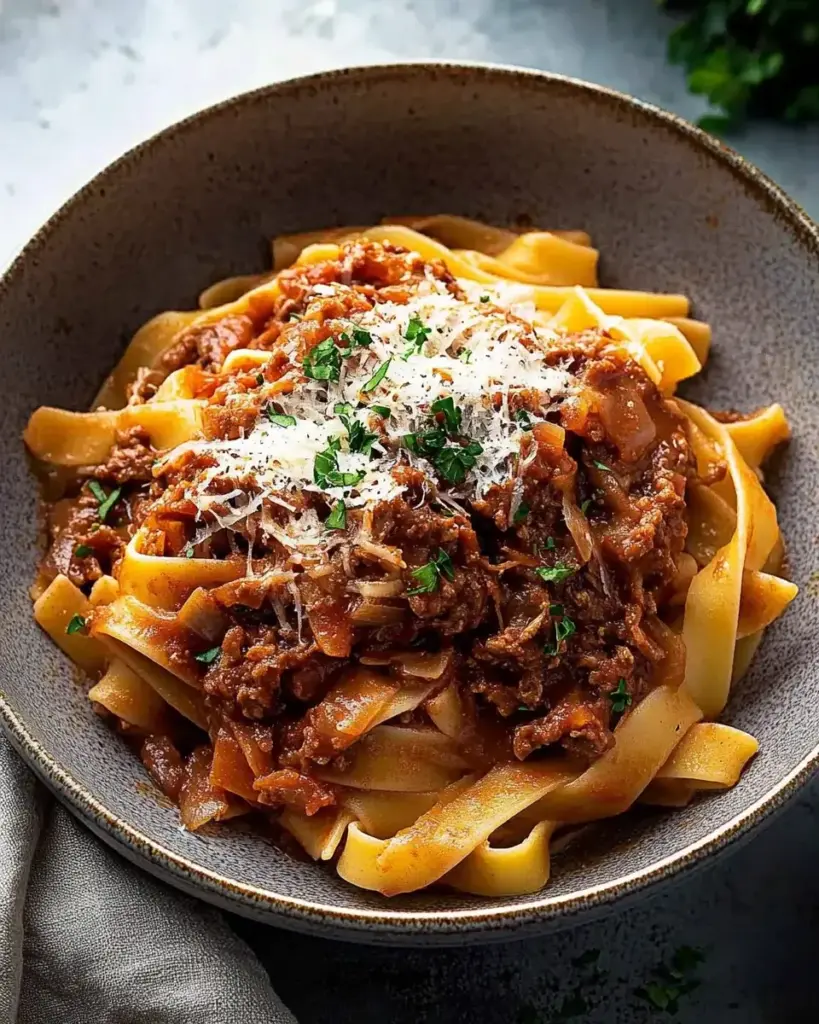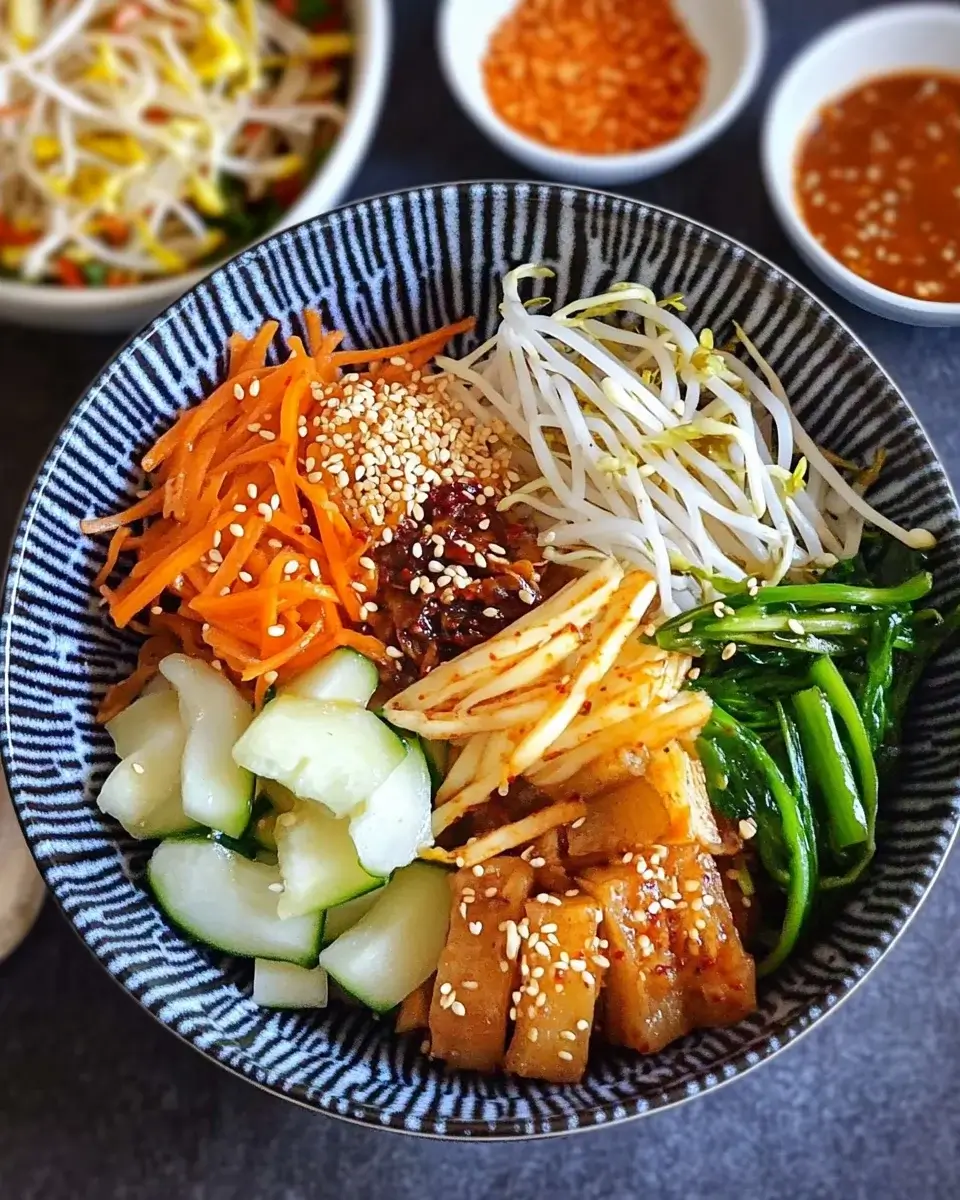
Introduction to Korean Veggie Bibimbap
There’s something magical about a bowl of Korean Veggie Bibimbap. It’s not just a meal; it’s a vibrant celebration of flavors and colors that can brighten even the busiest of days. I remember the first time I tried bibimbap at a local Korean restaurant. The mix of sautéed veggies, rice, and that spicy gochujang sauce was a revelation! This dish is perfect for anyone looking for a quick, nutritious solution that doesn’t skimp on taste. Whether you’re cooking for yourself or impressing friends, this recipe is sure to become a favorite in your kitchen.
Why You’ll Love This Korean Veggie Bibimbap
Korean Veggie Bibimbap is a game-changer for busy weeknights. It’s quick to whip up, taking just 30 minutes from start to finish. The best part? You can customize it with your favorite veggies, making it a versatile dish that never gets old. Each bite is a delightful explosion of flavors, thanks to the spicy gochujang and savory sesame oil. Trust me, this dish will have you coming back for seconds!
Ingredients for Korean Veggie Bibimbap
Gathering the right ingredients is key to making a delicious Korean Veggie Bibimbap. Here’s what you’ll need:
- Cooked white or brown rice: The base of your bibimbap, providing a hearty foundation.
- Baby spinach: Adds a fresh, vibrant touch and a boost of nutrients.
- Bean sprouts: These crunchy little gems bring texture and a mild flavor.
- Carrot: Julienned for sweetness and color, they brighten up the dish.
- Zucchini: Also julienned, it adds a tender bite and complements the other veggies.
- Shiitake mushrooms: Earthy and rich, they elevate the umami flavor profile.
- Vegetable oil: Used for sautéing, it helps bring out the flavors of the ingredients.
- Soy sauce: A savory seasoning that enhances the overall taste.
- Sesame oil: Adds a nutty aroma and depth to the dish.
- Garlic and ginger: Aromatics that infuse the dish with warmth and zest.
- Gochujang: This spicy Korean chili paste is the star of the show, giving bibimbap its signature kick.
- Sesame seeds: A crunchy garnish that adds a nutty flavor.
- Green onions: Chopped for a fresh, oniony bite that brightens the dish.
- Avocado (optional): Creamy slices can be added for richness and a modern twist.
- Salt and pepper: Essential for seasoning to taste.
Feel free to mix and match with your favorite vegetables, like bell peppers or broccoli, to make this dish your own. For exact quantities, check the bottom of the article where you can find them available for printing!
How to Make Korean Veggie Bibimbap
Creating a delicious Korean Veggie Bibimbap is easier than you might think. Follow these simple steps, and you’ll have a colorful, flavorful dish ready in no time. Let’s dive in!
Step 1: Sauté Aromatics
Start by heating vegetable oil in a large skillet over medium heat. Once it’s hot, toss in the minced garlic and ginger. Sauté them for about a minute until they release their fragrant aroma. This step sets the stage for the delicious flavors to come!
Step 2: Cook the Mushrooms
Next, add the sliced shiitake mushrooms to the skillet. Cook them for 3-4 minutes until they soften and become tender. Season with a pinch of salt and pepper to enhance their earthy flavor. Once done, remove the mushrooms from the skillet and set them aside.
Step 3: Sauté Carrots and Zucchini
In the same skillet, it’s time for the julienned carrots and zucchini. Sauté these vibrant veggies for about 3-4 minutes. You want them tender but still crisp. A little salt will help bring out their natural sweetness. Once they’re ready, remove them from the skillet and set aside.
Step 4: Wilt the Spinach and Bean Sprouts
Now, add the baby spinach and bean sprouts to the skillet. Cook for just 1-2 minutes until the spinach wilts down. This step adds a fresh, green element to your bibimbap. Once wilted, remove them from the heat.
Step 5: Assemble the Bibimbap
It’s assembly time! Divide the cooked rice among four bowls. On top of the rice, artfully arrange the sautéed vegetables, mushrooms, and bean sprouts. This colorful display is not just for looks; it’s a feast for the eyes!
Step 6: Add the Finishing Touches
Drizzle each bowl with soy sauce and sesame oil for that extra flavor boost. Don’t forget to add a generous dollop of gochujang to each bowl. Finally, garnish with sesame seeds, chopped green onions, and avocado slices if you’re feeling fancy. Serve immediately and mix everything together before digging in!
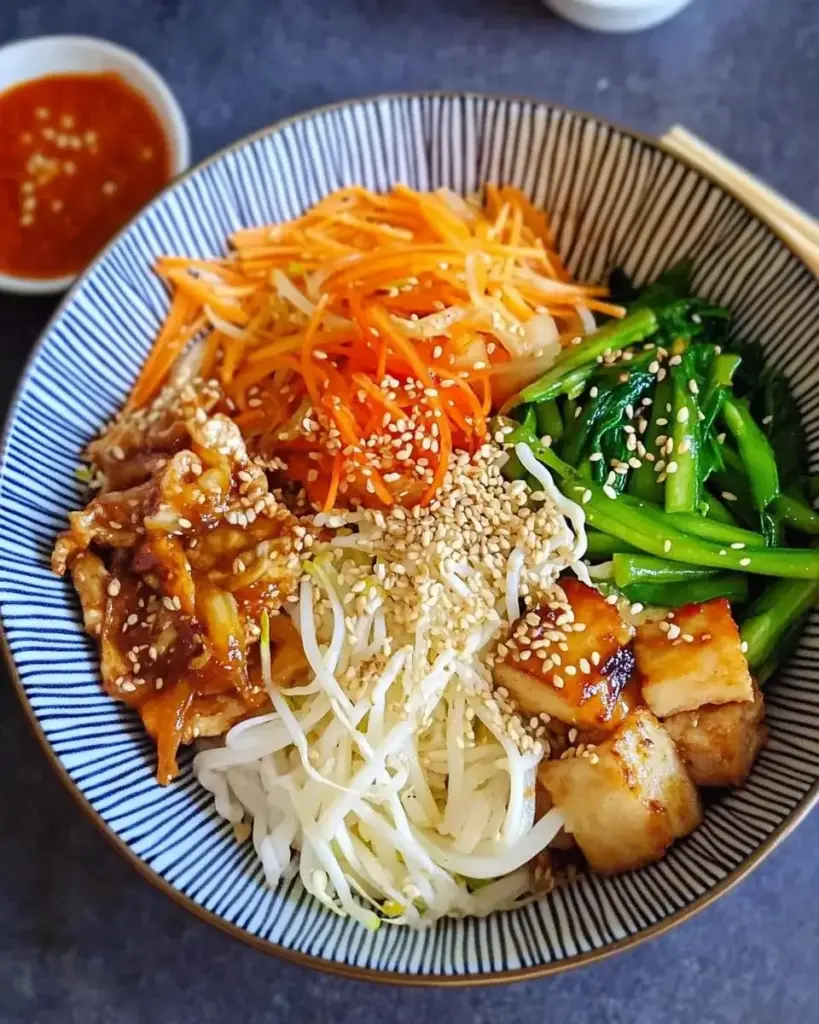
Tips for Success
- Prep your veggies ahead of time to save on cooking time.
- Use a non-stick skillet for easy sautéing and cleanup.
- Don’t overcrowd the pan; cook in batches if necessary.
- Adjust the amount of gochujang based on your spice preference.
- For a heartier meal, add a fried or poached egg on top.
Equipment Needed
- Large skillet: A non-stick skillet works best for easy sautéing.
- Cutting board: Essential for prepping your veggies.
- Sharp knife: A good knife makes slicing and julienning a breeze.
- Measuring spoons: Handy for precise ingredient amounts.
- Serving bowls: Use any bowls you have on hand for a beautiful presentation.
Variations
- Protein Boost: Add grilled chicken, beef, or tofu for a heartier meal.
- Spicy Kick: Mix in some sliced jalapeños or a sprinkle of red pepper flakes for extra heat.
- Different Grains: Swap out rice for quinoa or cauliflower rice for a low-carb option.
- Seasonal Veggies: Use whatever vegetables are in season, like asparagus in spring or squash in fall.
- Vegan Option: Omit the egg and ensure all sauces are plant-based for a vegan-friendly dish.
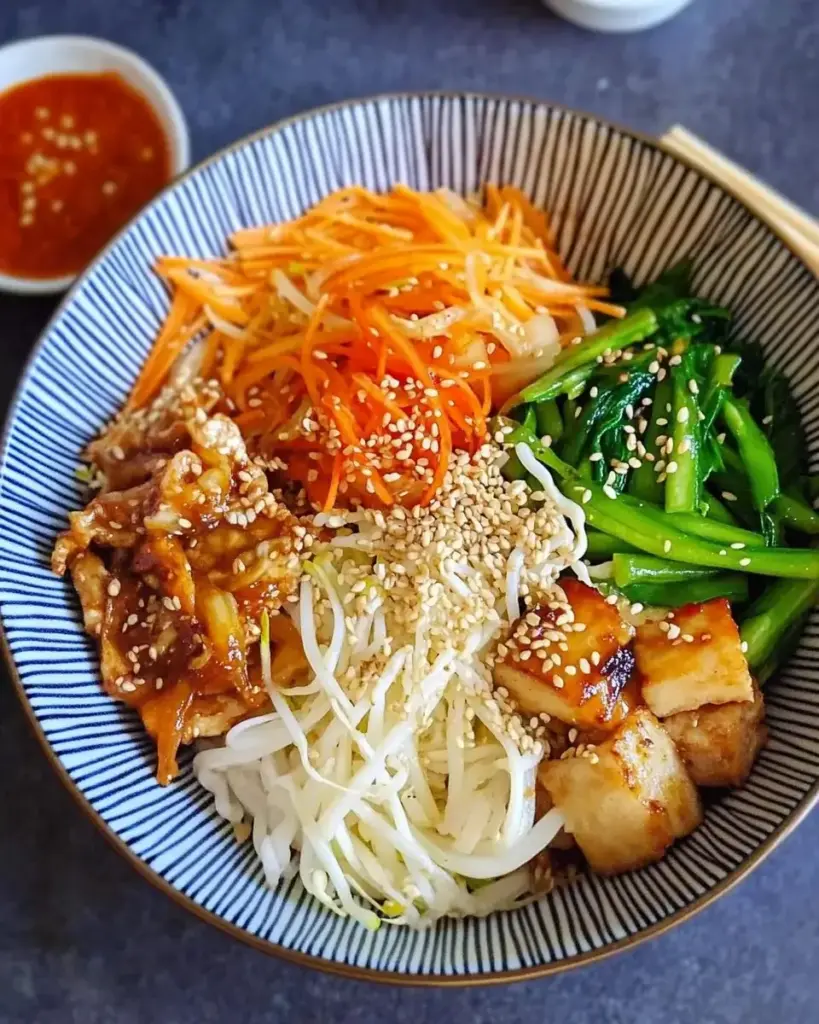
- Side Dishes: Pair with kimchi or pickled vegetables for a tangy contrast.
- Drinks: Enjoy with a refreshing iced green tea or a light lager.
- Presentation: Serve in colorful bowls to highlight the vibrant ingredients.
- Garnish: Add extra sesame seeds or a sprinkle of chili flakes for flair.
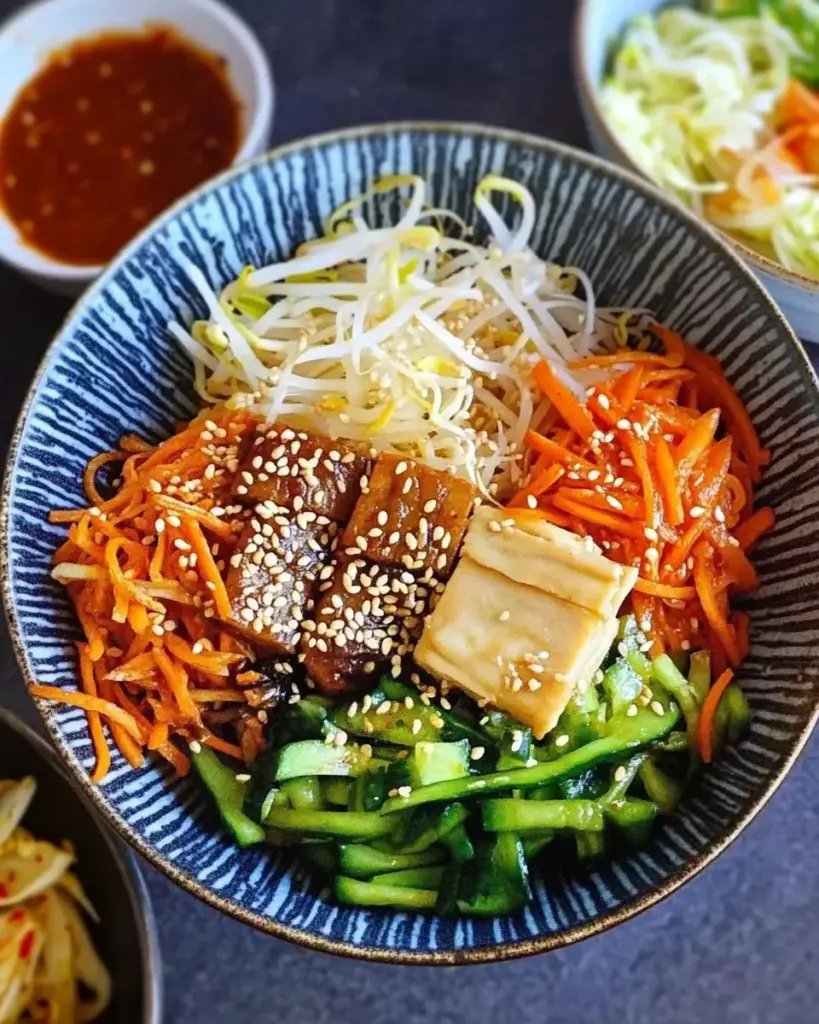
FAQs about Korean Veggie Bibimbap
What is bibimbap?
Bibimbap is a traditional Korean dish that translates to “mixed rice.” It features a base of rice topped with various sautéed vegetables, protein, and a spicy gochujang sauce. The beauty of bibimbap lies in its vibrant colors and flavors, making it a feast for both the eyes and the palate.
Can I make Korean Veggie Bibimbap ahead of time?
Absolutely! You can prepare the sautéed vegetables and rice in advance. Just store them separately in the fridge. When you’re ready to eat, reheat everything and assemble your bibimbap. This makes it a great option for meal prep!
Is Korean Veggie Bibimbap gluten-free?
To make your bibimbap gluten-free, simply use gluten-free soy sauce or tamari instead of regular soy sauce. This small swap allows you to enjoy the same delicious flavors without the gluten.
What can I substitute for gochujang?
If you can’t find gochujang, you can use a mix of miso paste and a bit of chili powder as a substitute. While it won’t have the exact same flavor, it will still add a nice kick to your bibimbap.
How can I make this dish vegan?
Making Korean Veggie Bibimbap vegan is easy! Just skip the egg topping and ensure that all sauces, like soy sauce and gochujang, are plant-based. You can also add more protein by including tofu or tempeh.
Final Thoughts
Cooking Korean Veggie Bibimbap is more than just preparing a meal; it’s about creating a colorful experience that brings joy to the table. Each bowl is a canvas, showcasing vibrant veggies and rich flavors that dance together in harmony. The satisfaction of mixing everything together before diving in is a ritual that makes every bite feel special. Whether you’re sharing it with family or enjoying a quiet night in, this dish is sure to warm your heart and fill your belly. Trust me, once you try it, you’ll be hooked on this delightful culinary adventure!
PrintKorean Veggie Bibimbap: A Flavorful Recipe You’ll Love!
- Total Time: 30 minutes
- Yield: 4 servings 1x
- Diet: Vegetarian
Description
Korean Veggie Bibimbap is a flavorful and colorful dish that combines rice with a variety of sautéed vegetables, topped with a spicy gochujang sauce.
Ingredients
- 2 cups cooked white or brown rice
- 1 cup baby spinach
- 1 cup bean sprouts
- 1 medium carrot, julienned
- 1 small zucchini, julienned
- 1 cup shiitake mushrooms, sliced
- 1 tablespoon vegetable oil
- 2 tablespoons soy sauce
- 1 tablespoon sesame oil
- 1 teaspoon garlic, minced
- 1 teaspoon ginger, minced
- 1 tablespoon gochujang (Korean chili paste)
- 2 teaspoons sesame seeds
- 2 green onions, chopped
- 1 avocado, sliced (optional)
- Salt and pepper to taste
Instructions
- In a large skillet, heat the vegetable oil over medium heat. Add the garlic and ginger, sautéing for about 1 minute until fragrant.
- Add the shiitake mushrooms to the skillet and cook for 3-4 minutes until they soften. Season with a pinch of salt and pepper. Remove the mushrooms from the skillet and set aside.
- In the same skillet, add the julienned carrot and zucchini. Sauté for 3-4 minutes until they are tender but still crisp. Season with a little salt. Remove from the skillet and set aside.
- Add the baby spinach and bean sprouts to the skillet, cooking for 1-2 minutes until the spinach is wilted. Remove from heat.
- To assemble, divide the cooked rice among four bowls. Arrange the sautéed vegetables, mushrooms, and bean sprouts on top of the rice.
- Drizzle with soy sauce and sesame oil, and add a dollop of gochujang to each bowl.
- Garnish with sesame seeds, chopped green onions, and avocado slices if using. Serve immediately and mix before eating.
Notes
- For added protein, top your bibimbap with a fried or poached egg.
- Feel free to substitute any of the vegetables with your favorites, such as bell peppers or broccoli, to customize the dish to your taste.
- Prep Time: 15 minutes
- Cook Time: 15 minutes
- Category: Main Dish
- Method: Sautéing
- Cuisine: Korean
Nutrition
- Serving Size: 1 bowl
- Calories: 350
- Sugar: 2g
- Sodium: 600mg
- Fat: 10g
- Saturated Fat: 1g
- Unsaturated Fat: 9g
- Trans Fat: 0g
- Carbohydrates: 55g
- Fiber: 4g
- Protein: 8g
- Cholesterol: 0mg






